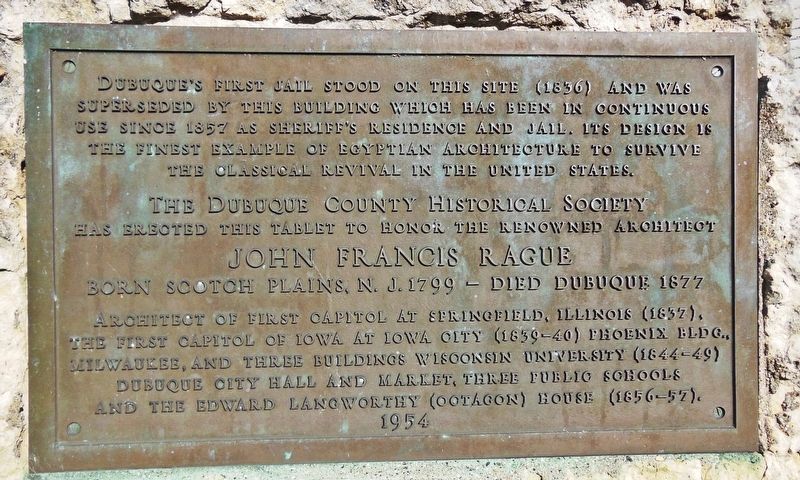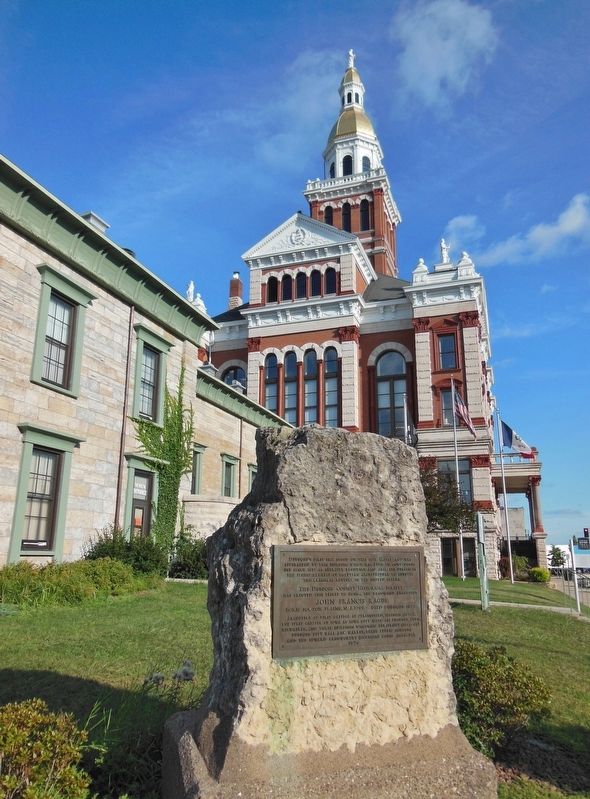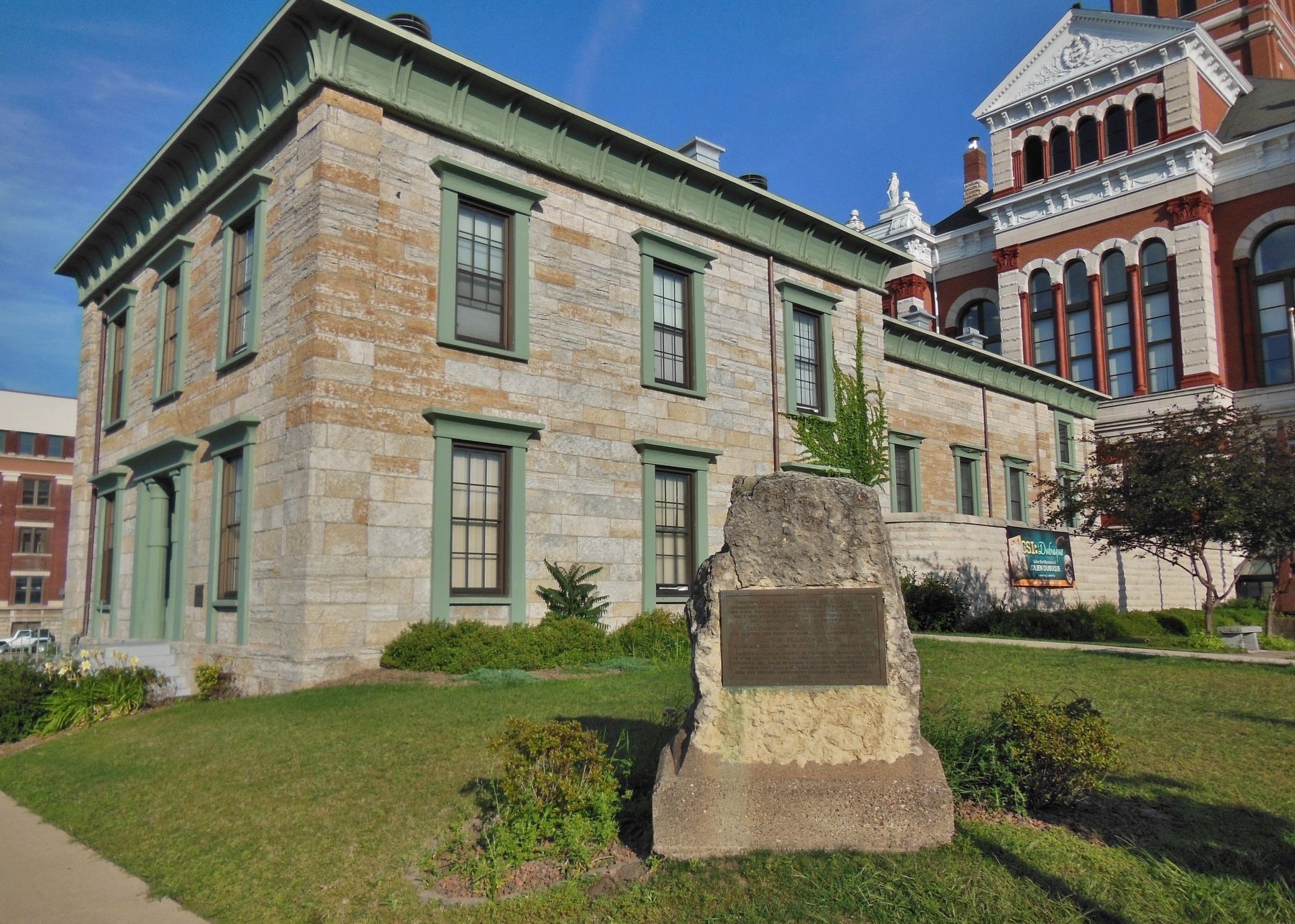Dubuque in Dubuque County, Iowa — The American Midwest (Upper Plains)
John Francis Rague
The Dubuque County Historical Society
has erected this tablet to honor the renowned architect
John Francis Rague
Born Scotch Plains, N.J. 1799 – Died Dubuque 1877
Architect of first Capitol at Springfield, Illinois (1837),
The first Capitol of Iowa at Iowa City (1839-40) Phoenix Bldg.,
Milwaukee, and three buildings Wisconsin University (1844-49)
Dubuque City Hall and Market, three public schools
and the Edward Langworthy (octagon) house (1856-57)
1954
Erected 1954 by The Dubuque County Historical Society.
Topics. This historical marker is listed in these topic lists: Architecture • Education • Law Enforcement. A significant historical year for this entry is 1857.
Location. 42° 30.083′ N, 90° 39.893′ W. Marker is in Dubuque, Iowa, in Dubuque County. Marker is at the intersection of Central Avenue (U.S. 52) and East 8th Street, on the left when traveling south on Central Avenue. Marker is located on the Dubuque County Veterans Affairs building grounds, at the southeast corner of the intersection. Touch for map. Marker is at or near this postal address: 36 East 8th Street, Dubuque IA 52001, United States of America. Touch for directions.
Other nearby markers. At least 8 other markers are within walking distance of this marker. Old Dubuque County Jail (a few steps from this marker); Grand Opera House (about 500 feet away, measured in a direct line); Methodist Chapel (approx. ¼ mile away); Five Flags Theater (approx. ¼ mile away); Iowa's First Church (approx. ¼ mile away); Abraham Lincoln (approx. 0.3 miles away); "Fourth Street Elevator" (approx. 0.4 miles away); Site of Tim Fanning's Log Tavern (approx. 0.4 miles away). Touch for a list and map of all markers in Dubuque.
More about this marker. Marker is a large metal plaque, mounted vertically on a large, tall stone monument.
Related markers. Click here for a list of markers that are related to this marker. Old Dubuque County Jail
Also see . . .
1. RAGUE, John Francis. In 1839 Rague planned Iowa's first capitol which stands today on the campus of the University of Iowa as "Old Capitol." Rague and the building committee soon were in disagreement, however, and he returned to Illinois where he was supervising the capitol's construction. In 1850 he received a commission to design several campus buildings at the University
of Wisconsin. The same year his Italianate Phoenix building in Milwaukee was constructed. This marked a change in his preferred style of architecture and a move away from attempts to seek institutional commissions. (Submitted on November 22, 2018, by Cosmos Mariner of Cape Canaveral, Florida.)
2. John Francis Rague - Pioneer Architect of Iowa. In 1858, Rague designed and built the Dubuque County Jail which still stands in service today. He modeled it closely after the old Tombs of New York, even down to the fierce, medieval-looking dungeons deep below the structure. When James O'Donnell Bennett, the literary and cultural critic of the Chicago Tribune was in Dubuque he marveled at “this gem of Egyptian architecture, transplanted across the Mississippi River.” (Submitted on November 22, 2018, by Cosmos Mariner of Cape Canaveral, Florida.)
3. John F. Rague. This link presents a photo gallery of Rague-designed buildings.
Rague moved to Springfield, Illinois in 1831. While there, he designed both the Illinois and Iowa capitol buildings, the Tinsley Dry Goods Building and many Greek Revival homes. In Springfield, Rague was a friend of Abraham Lincoln, and suggested Lincoln wear white gloves to dinner parties. Lincoln followed this recommendation. (Submitted on November 22, 2018, by Cosmos Mariner of Cape Canaveral, Florida.)
Credits. This page was last revised on November 19, 2019. It was originally submitted on November 21, 2018, by Cosmos Mariner of Cape Canaveral, Florida. This page has been viewed 272 times since then and 33 times this year. Photos: 1, 2, 3. submitted on November 21, 2018, by Cosmos Mariner of Cape Canaveral, Florida. • Andrew Ruppenstein was the editor who published this page.


